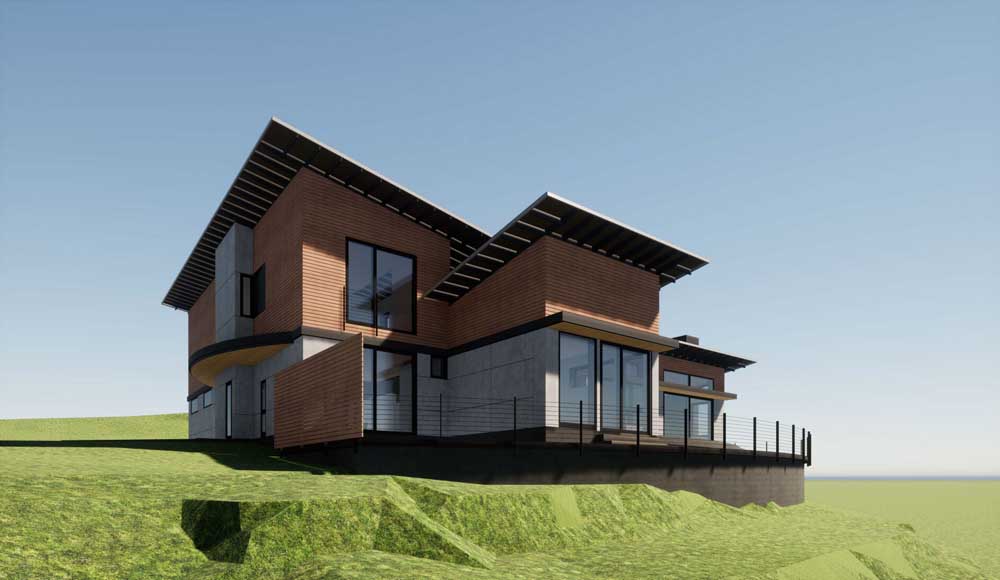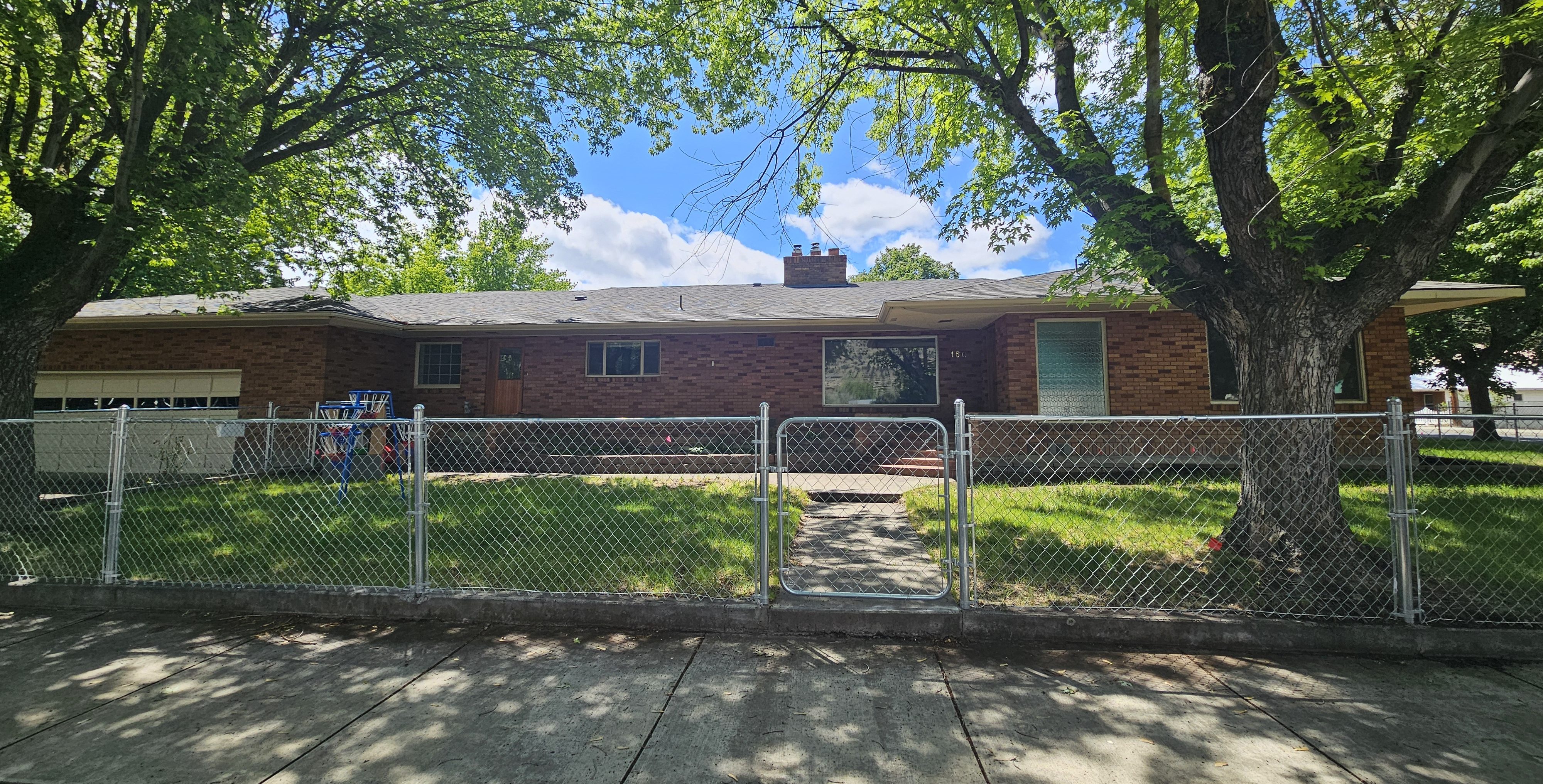Healing the planet part of blueprints for new Bend home
Published 5:00 am Sunday, April 17, 2022

- An artist’s rendering of River Sol, the Living Building Challenge project on the Deschutes River in Bend.
BEND — Lowering one’s carbon footprint with solar panels and other eco-friendly features has become a goal for many homebuilders in recent years. But when Bend residents Scott and Lisa May decided they also wanted to build an eco-friendly home, simply shrinking their footprint just wasn’t enough.
The couple decided to eliminate their footprint altogether.
The Mays are trying to build a 1,700-square-foot home that does not require any power, water, or sewer hookup from the city of Bend. The captured rainwater that they plan to use will be recycled onsite. The $1.6 million home will be constructed with toxin free materials of the highest environmental standard.
Building at the highest ecological standards is all part of a goal to have their home receive a Living Building Challenge certification, the Mays said. Seattle-based International Living Future Institute, a nonprofit organization, created the requirements for the challenge in 2006 and the rules have grown even more stringent since then.
The Mays did not buy the property near First Street Rapids in Bend with the intention of gaining Living Building certification. They only found out about the program in 2018 from a friend. A quick scan of the Living Future Institute website was all Lisa May needed to switch gears.
“We were far along the line with a traditional building concept, but the minute I read the Living Building concept I knew we were going to do the project. Scott totally agreed immediately,” said Lisa May.
They started researching the requirements for their project — a two bedroom/two bath downstairs unit and a separate one bedroom/one bath upstairs unit. It seemed doable for the couple and their two pets, a Norwegian forest cat named Olivia and a blue front Amazon parrot named Oscar.
Sustainable way of living
Why go to such extreme lengths to help the planet?
“It’s a complete embodiment of what we believe to be required for us to save the planet and to have a sustainable way of living and being,” said Lisa May. “And to be able to embody and share it with other people was the call.”
The Mays see the project as a reflection of their careers in food, health, wellness and sustainability. Scott May is a food scientist whose work revolves around supporting the development of a regenerative food system. As a holistic leadership development coach, Lisa May’s career is focused on finding solutions to help people reach their goals using science-based models and tools.
One motivating factor for the project is they will be able to coach others to follow a similar path. They hope to show that it is within reach of home builders who have a moderate budget.
“The motivation behind this is that it fits our desire to create sustainable solutions for the future,” said Scott May. “My working life is all about creating the future of food. A big challenge for our planet is the food system, along with the way we build homes, which is currently unsustainable. It fits in with our way of life and our way of thinking and our way of living.”
When it’s done, River Sol, which the owners call their home, will be one of the most energy- and water- efficient homes on the planet.
Tougher than LEED
The requirements for achieving Living Building Challenge status are the strictest in the world, pushing the boundaries even past the requirements for a platinum rating of the U.S. Green Building Council’s Leadership in Energy and Environmental Design, or LEED, program.
While the LEED rating system gives points for water conservation, energy efficiency, waste management, Living Buildings must meet the standards of all seven “petals” of the program.
Take irrigation, for example. While LEED gives points for irrigation-free landscaping, Living Buildings must be a source of local organic food production.
As for energy use, LEED gives points for optimal energy use whereas Living Buildings must generate more energy than they use. When it comes to water use, LEED gives points for high efficiency plumbing while a Living Building can only use captured rainwater.
Rules around materials are also stricter for Living Buildings, which cannot have any materials from the so-called Red List of 813 toxic building compounds. Building materials must also be sustainably sourced. Crews working on Living Buildings can’t simply go down to Home Depot and pick up some PVC piping, for example, because polyvinyl chloride is banned in Living Buildings.
Recycling Water
Large, rooftop solar panels and rain capturing ingenuity will help the Mays achieve the energy and water efficiency petals of the Living Building Challenge. They must also reuse and recycle all their water, to the point where a city sewer connection will be moot. The city of Bend requires connection to the city water and sewer systems but the goal is to not use them.
Once the home is complete, the couple won’t automatically receive a Living Building Challenge certificate. The Mays are required to live in their home for 12 months and prove with a third party audit that the building performs according to its original intent.
The Mays broke ground on their home last month, laying a foundation made partially from recycled concrete. Once complete a year from now, the building will be topped with more solar panels than the building actually needs. Excess energy will be stored in batteries for use when solar power is not possible.
Greywater, which is water from sinks and showers that has been treated and purified, will be used for watering the property. The wastewater from toilets, or blackwater, will be sent to a special tank for decomposition by microorganisms. The end result will be a nutrient-rich mulch to be spread on the property.
The microorganisms “are happy campers and they just continue to feed off the human waste and they convert it into a beautiful carbon source,” said May.
There is no lucrative award for passing the Living Building Challenge. But recipients can take personal pride that they have joined an elite group — the institute has awarded challenge certificates to around 400 buildings worldwide.
The purpose of the challenge is to showcase how homes of the future can employ modern technologies to make the most out of increasingly scarce resources. At its essence, certified buildings will be giving back to the community by producing energy and food. The idea is that these buildings do their part to heal the planet.
Reducing carbon emissions is another motivator for the institute to promote Living Building Challenge projects as the world faces a climate change crisis.
Bend Leading the Way
Bend is doing its part to be a leader in these types of buildings. In 2014, another Bend couple completed work on their Living Building Challenge home, known as the Desert Rain project. Desert Rain, built at a cost of $3.48 million, was designed by Bend-based architect Al Tozer. The Mays have also employed Tozer to design their home.
Desert Rain was the first residential property in the United States to be certified by the Living Building Challenge. It’s still the only home in Oregon certified as a Living Building Challenge member.
A third project in Bend is trying for “petal certification,” another Living Future Institute designation, one rung lower than the Living Building Challenge. Tozer said these projects will put Bend on the map as a national leader in “deep green” architectural design and construction.
“Bend will be on the map and not just in Oregon but throughout the country as a hub of living buildings,” said Tozer. “Which would be spectacular.”
Conservation requirements from the Living Futures Institute have been tightened since Desert Rain was built. However, technologies have also improved, notably in solar panel efficiency.
River Sol’s rooftop solar panels will create net positive energy for the main home and upstairs additional dwelling unit. Backup power needs to be available for a week’s worth of time, said Tozer.
What About Water?
Scott May, a Portland native and graduate of Oregon State University, said water will be the biggest challenge in the certification process. A closed-loop system will allow the reuse of rainwater throughout the home.
May said he will try to use only water captured from rain but if more water is needed, he can use hydropanels — devices suck moisture out of the air to produce a few gallons of potable water each day.
From an architectural standpoint, the home will be modern and clean, but not cold, said Tozer. Trees surround the home so the solar panels will be strategically placed in a location that receives the most sunlight. This need for optimal sun exposure dictates where the home will be located on the property.
Keeping the Deschutes River in view also dictates how the building and its patio are configured. Tozer said biophilic design— a concept that tries to connect the home’s occupants to the natural environment — is also part of the architectural plan.
“It’s a way to honor place, and River Sol, like Desert Rain, was informed by biophilic design,” said Tozer.
Construction on River Sol will be followed by the planting of food-producing trees and plants in the yard.
Sustainably harvested wood will be the primary construction material for the house.
More Units Planned
In addition to their main home, the Mays also plan to build four additional homes on adjacent tax lots. Shipping containers will be used as frames for the new homes, which will also employ ultra-efficient energy and water use systems.
Each of the shipping container homes will also include an ADU, essentially doubling the number of dwelling structures to eight. The Mays plan to sell the shipping container homes once they are complete. It’s not yet clear if the four additional homes will meet Living Building Challenge criteria but the Mays believe it’s possible.
“We will try to go for the whole thing but it’s still to be determined,” said May. “We will attempt to achieve as many living building petals as we can.”
The push to develop highly energy and water efficient homes could not come at a better time, as Central Oregon continues to suffer through its worst drought in a century. Water efficiency will be needed as snowpack declines and net-zero buildings will help to reduce Bend’s dependence on fossil fuels for energy.
May said his intention is to “stand on the shoulders” of earlier projects like Desert Rain, while also providing inspiration for others to follow, showing that these types of projects can be done at a cost that is lower than it was a few years ago.
“Hopefully someone can do the next after ours and stand on our shoulders,” said May. “It’s a viable way of creating a home that allows us to do our part in saving the planet but doing it in a way that demonstrates scalability.”





